100W Monocrystalline Silicon Solar Cells PV Module 182MM 36Cells 210MM 32Cells CNBM
- Price:
- US $44.08 / pc
- Loading Port:
- SHANGHAI
- Delivery Time:
- 15 days after your payment
- Option:
- 210mm 182mm
- Quantity:
- Shipping:
- Freight Cost Calculator
OKorder Service Pledge
Quality Product, Order Online Tracking, Timely Delivery
OKorder Financial Service
Credit Rating, Credit Services, Credit Purchasing
You Might Also Like
Item specifice
Material:
Monocrystalline Silicon
Max. Power(W):
100
Number of Cells(pieces):
32
100W Monocrystalline Silicon Solar Cells PV Module 182MM 36Cells
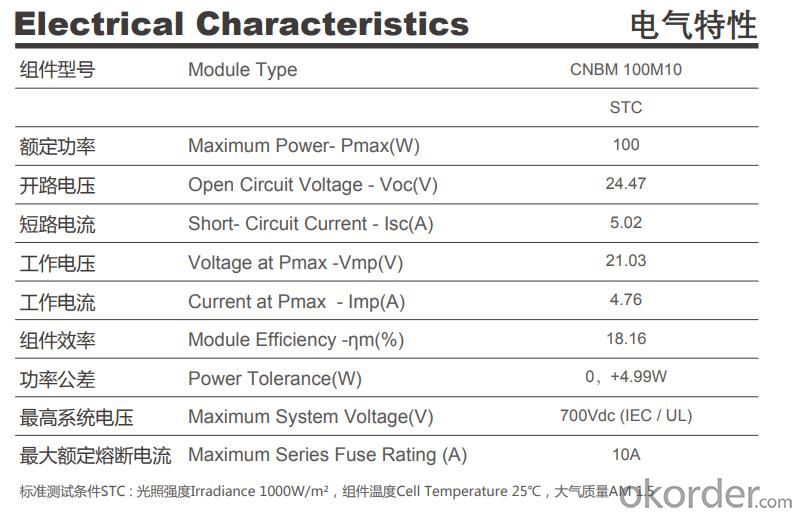

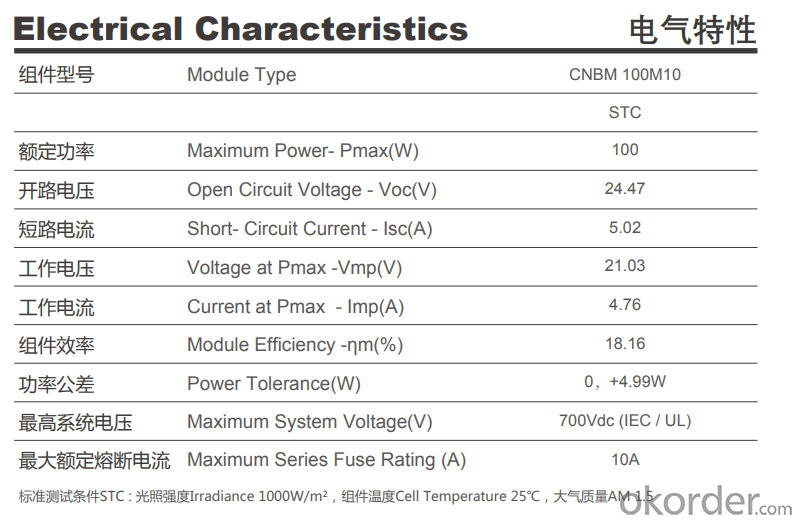
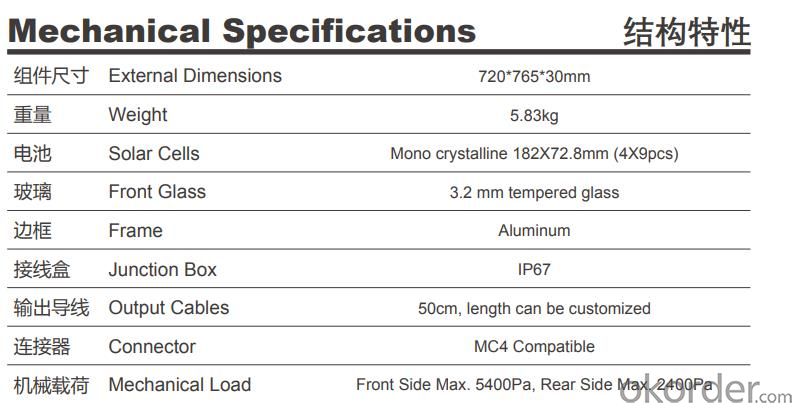
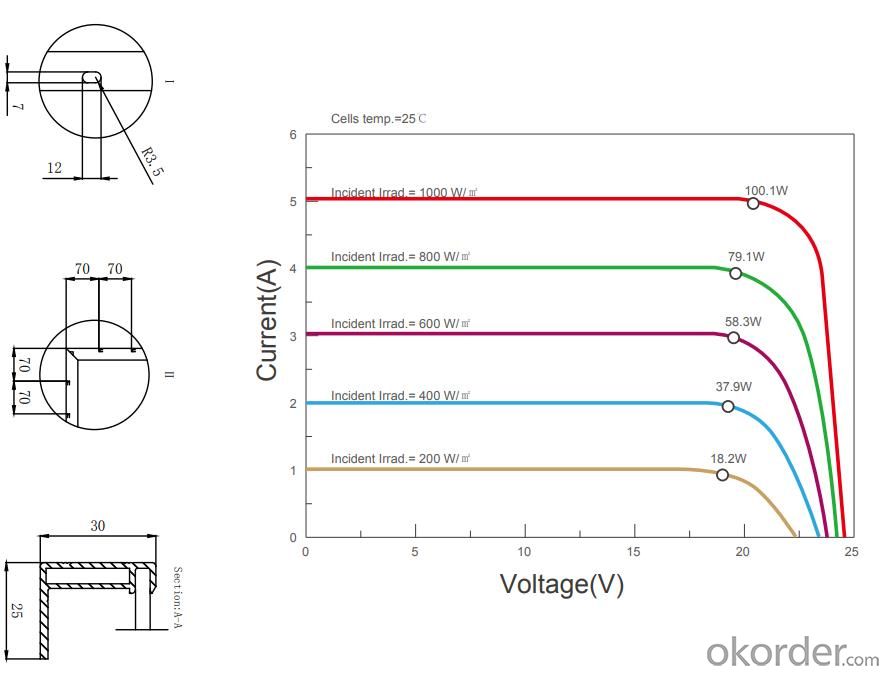
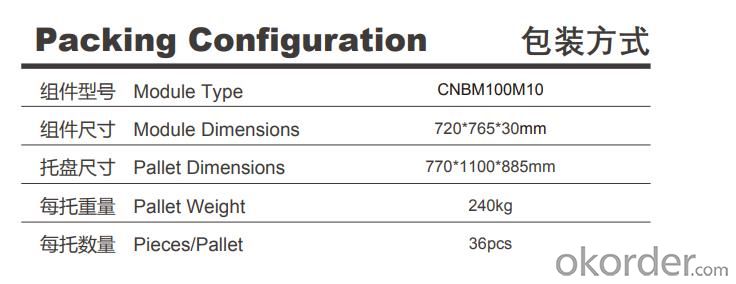
- Q:What is the maximum efficiency possible for a solar cell?
- The maximum efficiency possible for a solar cell, also known as the Shockley-Queisser limit, is approximately 33.7%.
- Q:How do solar cells perform in areas with high levels of humidity?
- Solar cells generally perform slightly less efficiently in areas with high levels of humidity. This is because the moisture in the air can scatter and absorb some of the sunlight before it reaches the solar cell, reducing its overall power output. However, modern solar cell technologies have been developed to minimize this effect and maintain a satisfactory performance even in humid conditions.
- Q:What is the effect of wind on solar cell performance?
- The effect of wind on solar cell performance can be both positive and negative. On one hand, a gentle breeze can help cool the solar panels, preventing them from overheating and improving their efficiency. On the other hand, strong winds can cause vibrations and movement in the panels, leading to potential damage or misalignment. Therefore, while some wind can be beneficial, excessive or turbulent winds can have a detrimental impact on solar cell performance.
- Q:Solar water heater plate can be directly converted into electrical energy?
- Modern solar thermal technology combines sunlight and uses its energy to generate hot water, steam and electricity. In addition to using the right technology to collect solar energy, buildings can also use the sun's light and heat, by adding the appropriate design Equipment, such as a giant south window or the use of building materials that absorb and slowly release the sun's heat.
- Q:What are the advantages of using solar cells?
- One of the main advantages of using solar cells is that they harness renewable energy from the sun, which is an abundant and sustainable resource. Solar cells are environmentally friendly as they produce clean energy, emitting no greenhouse gases or pollutants. They also provide energy independence, reducing reliance on fossil fuels and decreasing energy costs over time. Solar cells require minimal maintenance and have a long lifespan, making them a cost-effective option in the long run. Additionally, they can be installed in remote areas where it may be challenging to access traditional electricity grids, providing electricity to communities that otherwise would not have access.
- Q:Can solar cells be used in off-grid applications?
- Yes, solar cells can definitely be used in off-grid applications. Off-grid systems rely on renewable energy sources like solar power to generate electricity independently from the main power grid. Solar cells, also known as photovoltaic cells, convert sunlight directly into electricity and can be used to power various off-grid applications such as remote cabins, boats, or even outdoor lighting systems. The ability of solar cells to operate without the need for a connected power grid makes them ideal for off-grid scenarios where access to electricity is limited or unreliable.
- Q:Can solar cells be used for powering communication systems?
- Yes, solar cells can be used to power communication systems. Solar cells convert sunlight into electrical energy, which can then be used to power various electronic devices, including communication systems. This renewable source of energy is a sustainable and environmentally friendly option for powering communication systems, especially in remote or off-grid locations where access to traditional power sources may be limited.
- Q:Can solar cells be used in smart home automation systems?
- Yes, solar cells can be used in smart home automation systems. Solar cells can generate electricity from sunlight and can be integrated into the smart home system to power various devices and sensors. This allows for energy-efficient and sustainable operation of the automation system, reducing reliance on conventional power sources and lowering electricity costs.
- Q:Can solar cells be used in floating solar farms?
- Yes, solar cells can be used in floating solar farms. Floating solar farms, also known as floating solar panels or floating photovoltaic systems, involve placing solar panels on bodies of water such as lakes, reservoirs, or even the ocean. These solar panels are designed to float on the water's surface and capture sunlight to generate electricity. Floating solar farms are increasingly being adopted as they have numerous advantages, including efficient land use, reduced evaporation, and increased energy production due to the cooling effect of the water.
- Q:Can solar cells be used in healthcare facilities?
- Yes, solar cells can be used in healthcare facilities. They can be employed to generate electricity, which can power medical equipment, lighting, and other essential systems in healthcare facilities. Solar energy can help reduce reliance on the conventional power grid, providing a sustainable and cost-effective source of electricity for healthcare facilities, especially in remote or off-grid areas. Additionally, solar cells can contribute to reducing carbon emissions and promoting environmental sustainability in the healthcare sector.
1. Manufacturer Overview |
|
|---|---|
| Location | |
| Year Established | |
| Annual Output Value | |
| Main Markets | |
| Company Certifications | |
2. Manufacturer Certificates |
|
|---|---|
| a) Certification Name | |
| Range | |
| Reference | |
| Validity Period | |
3. Manufacturer Capability |
|
|---|---|
| a)Trade Capacity | |
| Nearest Port | |
| Export Percentage | |
| No.of Employees in Trade Department | |
| Language Spoken: | |
| b)Factory Information | |
| Factory Size: | |
| No. of Production Lines | |
| Contract Manufacturing | |
| Product Price Range | |
Send your message to us
100W Monocrystalline Silicon Solar Cells PV Module 182MM 36Cells 210MM 32Cells CNBM
- Price:
- US $44.08 / pc
- Loading Port:
- SHANGHAI
- Delivery Time:
- 15 days after your payment
- Option:
- 210mm 182mm
- Quantity:
- Shipping:
- Freight Cost Calculator
OKorder Service Pledge
Quality Product, Order Online Tracking, Timely Delivery
OKorder Financial Service
Credit Rating, Credit Services, Credit Purchasing
Similar products
New products
Hot products
Hot Searches
Related keywords


























